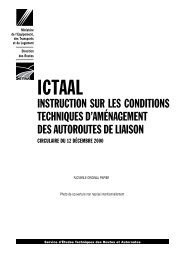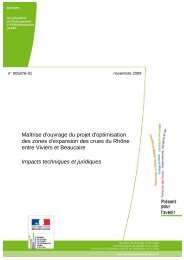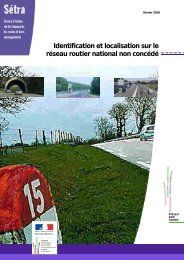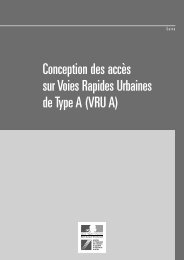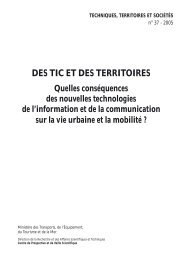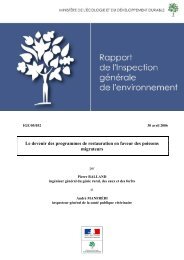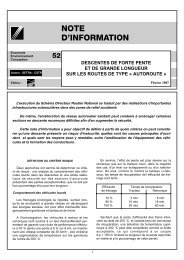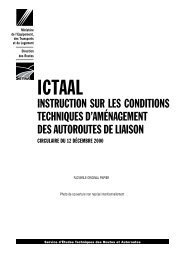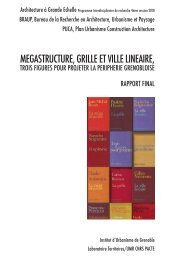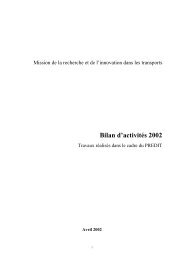Daniel Kaplan - Portail documentaire du Ministère de l'Ecologie
Daniel Kaplan - Portail documentaire du Ministère de l'Ecologie
Daniel Kaplan - Portail documentaire du Ministère de l'Ecologie
You also want an ePaper? Increase the reach of your titles
YUMPU automatically turns print PDFs into web optimized ePapers that Google loves.
236<br />
partners. And there are households and companies<br />
with their own view of what is spatially <strong>de</strong>sirable.<br />
Yet planning actors and <strong>de</strong>cision-makers on the<br />
national level try to impose top down uniform<br />
blueprints of spatial structure such as the compact<br />
city. This is hardly a good practice of organized<br />
complexity. A new approach, embracing the<br />
principle of subsidiarity, could stimulate multioption<br />
thinking bottom up; also taking the form of<br />
online planning (cf. “Physical and virtual space.<br />
How to <strong>de</strong>al with their interaction?”, supra, p. 229).<br />
Networks as central concept<br />
Dupuy (1991) distinguishes three interacting<br />
levels of network operators that (re)organize urban<br />
space as shown in figure 1 (cf. “Physical and virtual<br />
space. How to <strong>de</strong>al with their interaction?”, supra,<br />
p. 231).<br />
Level one involves the suppliers of technical<br />
networks. They are specialized and organized in<br />
sectors.<br />
On level two we find functional networks of<br />
common-interest users centering on consumption,<br />
pro<strong>du</strong>ction, distribution and personal contacts. To<br />
each of these networks specific location factors<br />
apply.<br />
It is at level three that the operators of<br />
functional networks make actual, selective use of<br />
technical networks for their special purposes. The<br />
resulting networks represent virtual cities. Virtual<br />
means being functionally but not formally of its kind.<br />
These virtual cities tend to clash with how planning<br />
actors usually view a <strong>de</strong>sirable spatial structure.<br />
The three-layered has been successfully applied<br />
to the Internet three times on the European and<br />
national levels (Drewe 1999 a, b; 2000 a).<br />
In each case, level one corresponds to the<br />
Internet infrastructure. The ISP transit backbone<br />
has been chosen as it is closest to the users. On level<br />
two, the “Internet in<strong>du</strong>stry” is analyzed, that is the<br />
commercial domain as it leads over other domains.<br />
And, finally, level three refers to actual traffic on or<br />
performance of the Internet.<br />
With suppliers of technical networks at level<br />
one, networks are urban-technology based. All kind<br />
of technical networks are involved: water, sewer,<br />
energy, transport, conventional telecommunication<br />
and ICT. The behavior of the different operators is<br />
in itself an important research topic what with the<br />
policies of privatization and liberalization and the<br />
issue of social exclusion or universal service.<br />
Paul Drewe<br />
In or<strong>de</strong>r to illustrate how important urban<br />
technology is for urbanism or spatial planning, let<br />
us single out the road network and the private car<br />
(because it has never been property conceptualized<br />
spatially). Mainstream urbanism has rather been<br />
dominated by zonal thinkers like Le Corbusier as<br />
opposed to network thinkers such as Cerda, Wright<br />
or Rouge (Dupuy, 1991). Creating monofunctional<br />
zones for dwellings, work and facilities (recreation)<br />
naturally in<strong>du</strong>ces traffic between those zones. The<br />
rise of the automobile and the accompanying<br />
expansion of the road network have pro<strong>du</strong>ced a<br />
“mobility problem” that is still unsolved today.<br />
More generally speaking, the Athens Charter of<br />
1933 that served as a blueprint for post-war<br />
urbanism is based on two false premises:<br />
• “(a) It is <strong>de</strong>sirable to concentrate functions into<br />
giant packages; (b) The geometry within each<br />
package is homogeneous. Nevertheless, a city<br />
contains so many complex human functions that it<br />
is impossible to isolate them, let alone concentrate<br />
them, so that imposing a simplistic geometry on<br />
urban form inhibits the human activities that<br />
generate living cities” (Salingaros, 2000:15).<br />
The ‘Network City’, a <strong>de</strong>sign studio<br />
The Network City <strong>de</strong>sign studio is another<br />
example of the search for new concepts. It is a<br />
cooperation between the Ministry of VROM and<br />
the Faculty of Architecture at Delft University of<br />
Technology (http://www.networkcity.nl). The<br />
studio involves staff members, PhD stu<strong>de</strong>nts,<br />
stu<strong>de</strong>nts in their final year and representatives of<br />
VROM’s central directorate.<br />
The studio approach is one of <strong>de</strong>sign-oriented<br />
research aiming at possible futures – as <strong>de</strong>sign can<br />
<strong>de</strong>monstrate or visualize what could be. Possible<br />
futures relate to the long term. In or<strong>de</strong>r to bridge the<br />
gap between a distant future and today’s practice, a<br />
number of location specific test-beds has been chosen:<br />
among them “the future urban agglomeration”.<br />
Conventionally, urban agglomerations (in the<br />
Netherlands) are approached as a hierarchy of areas,<br />
looking from the insi<strong>de</strong> out:<br />
– the (historic) city center (as the “pe<strong>de</strong>strian city”),<br />
– pre-war inner-city neighborhoods,<br />
– post-war resi<strong>de</strong>ntial suburbs (or housing estates),<br />
– recent expansion areas (including the VINEX<br />
locations),<br />
– the outer periphery (villages and the nearly<br />
countrysi<strong>de</strong>).<br />
As a contrast, it is possible to <strong>de</strong>sign the future<br />
agglomeration also from the outsi<strong>de</strong> looking in.



